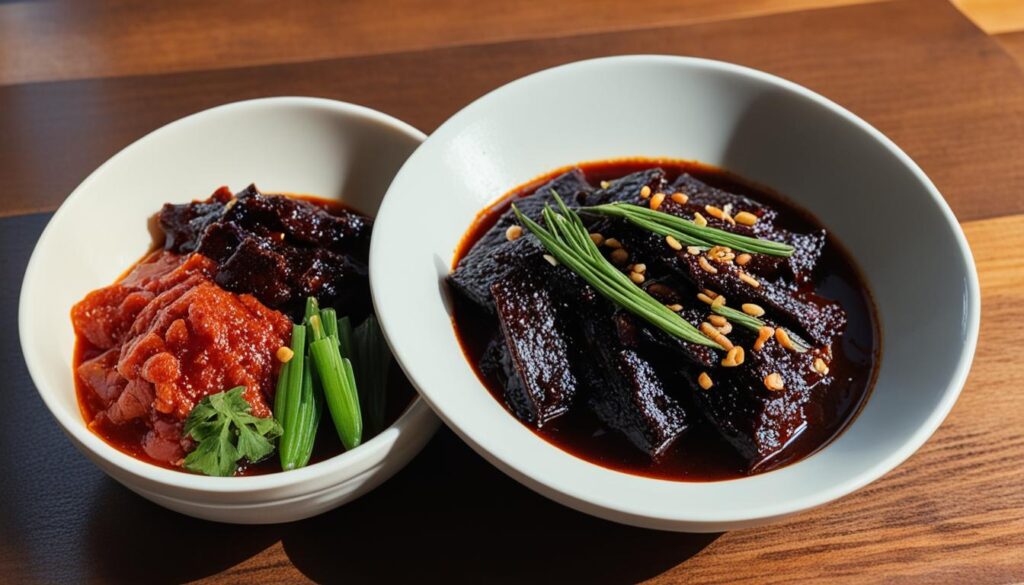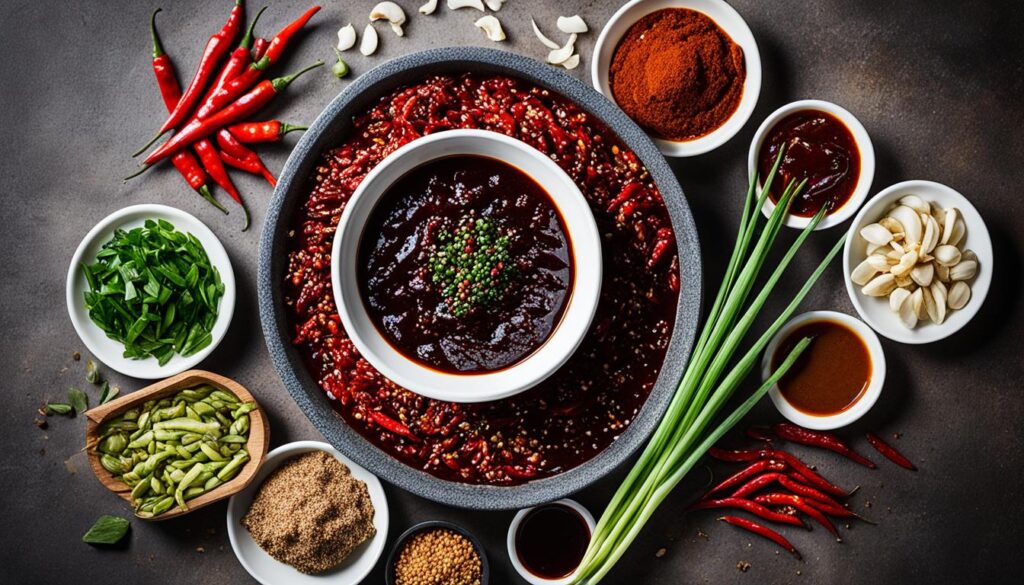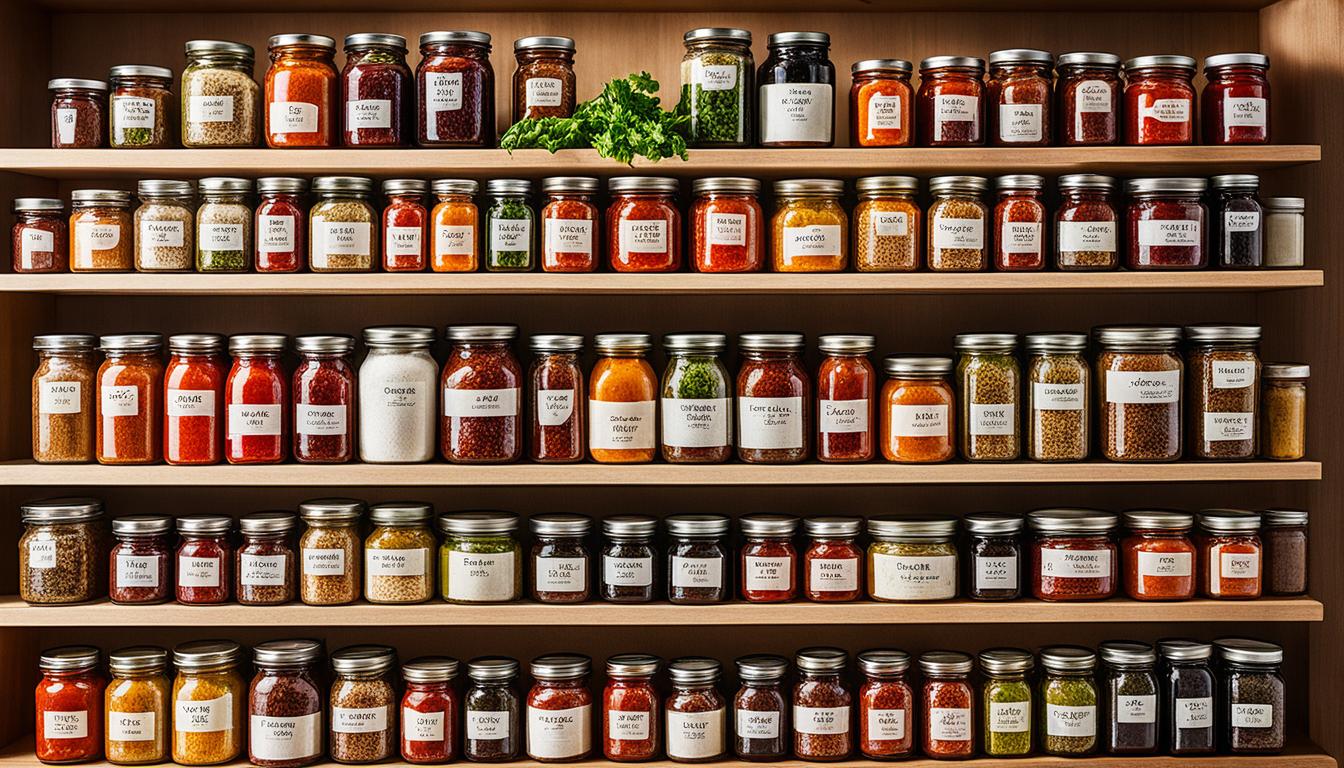Have you ever wondered how to stock a Korean pantry? Or what are the essential ingredients needed to cook authentic Korean dishes? Well, you’re in luck! In this article, we will uncover the secret to creating delicious Korean cuisine at home by exploring the must-have items for a Korean pantry.
From traditional condiments like jeot jang to versatile ingredients like soy sauce and gochujang, we will delve into the world of Korean cooking staples. Along the way, we will discover the diverse flavors and traditional cooking techniques that make Korean cuisine so unique.
So, are you ready to embark on a culinary journey to Korea? Let’s dive in and uncover the secrets of the Korean pantry.
Understanding the Korean Pantry
Korean cuisine is more than just kimchi and barbecue. It encompasses a wide variety of dishes, from mild rice porridges to savory dumplings. While Korean cuisine varies by region, there are core ingredients that are common in nearly all Korean kitchens. Understanding the essentials of the Korean pantry is crucial for cooking authentic dishes and experiencing the diverse flavors of this cuisine.
When it comes to stocking your Korean pantry, there are a few essential pantry items that you should always have on hand. These ingredients form the foundation of Korean cooking and are used to enhance the flavors of various dishes.
One staple ingredient you will find in nearly every Korean kitchen is rice. Short grain white rice is the preferred variety and serves as the staple grain in Korean cuisine. It is used as a base for many dishes and is the perfect accompaniment to savory Korean stews, barbecue, and other main dishes.
Another essential pantry item is sesame oil. This aromatic oil is made from toasted sesame seeds and adds a distinct nutty flavor to dishes. It is commonly used as a finishing oil and is drizzled over stir-fried vegetables, noodle dishes, or rice. Sesame oil also plays a crucial role in creating authentic Korean marinades and dressings.
Lastly, perilla oil is a lesser-known but equally important ingredient in Korean cooking. Made from roasted perilla seeds, this oil is often used in vegetable side dishes, providing a unique herbal flavor. It pairs well with dishes like Korean pancakes (jeon) and adds depth to the overall flavor profile.
To summarize, understanding the essentials of the Korean pantry is key to creating authentic Korean dishes. By stocking your pantry with items like rice, sesame oil, and perilla oil, you can elevate the flavors of your Korean cooking and immerse yourself in the diverse and delicious world of Korean cuisine.
Jang: The Foundation of Korean Cooking
Jang, or sauces, are the foundation of Korean cooking. These essential ingredients add depth and flavor to dishes, elevating the taste of Korean cuisine. In every Korean kitchen, you will find three types of jang: ganjang (soy sauce), doenjang (soybean paste), and gochujang (chile paste).
Ganjang (Soy Sauce)
Ganjang, also known as soy sauce, is a versatile and essential condiment in Korean cooking. It is made through a fermentation process using soybeans, wheat, and salt. Ganjang adds a savory umami flavor to a wide variety of dishes, including soups, stews, marinades, and stir-fries. Its rich aroma and deep flavor make it a key ingredient in many Korean recipes. Whether you’re marinating meat or seasoning a hearty bowl of bibimbap, ganjang is an indispensable component of authentic Korean flavors.
Doenjang (Soybean Paste)
Doenjang, a traditional Korean soybean paste, is another essential sauce in Korean cuisine. Made from fermented soybeans, doenjang offers a deep and savory flavor to various dishes, such as soups, stews, and dipping sauces. It is often used as a base for doenjang jjigae, a hearty soybean paste stew packed with umami. Incorporating doenjang into your cooking adds complexity and richness to your dishes, enhancing the depth of flavors and making them truly authentic.
Gochujang (Chile Paste)
Gochujang, a staple Korean condiment, is a savory and spicy chili paste made from fermented soybeans, chili powder, glutinous rice, and salt. It offers a unique balance of sweetness, spiciness, and umami flavors. Gochujang is used in a wide range of dishes, including marinades, stews, stir-fries, and even as a dipping sauce for Korean BBQ. Its distinctive taste and versatility make it an essential ingredient in Korean cooking. Adding gochujang to your dishes will bring a delightful kick of heat and depth of flavor that cannot be replicated with any other ingredient.

Understanding the different types of jang, ganjang, doenjang, and gochujang, is crucial for mastering Korean cooking. These sauces provide the foundation and building blocks of authentic Korean flavors. Incorporating them into your dishes will unlock an array of taste sensations and take your culinary skills to new heights.
Soy Sauce: The Versatile Seasoning
Soy sauce is a key ingredient in Korean cuisine, known for its ability to enhance flavors and add depth to dishes. With its umami-rich taste, it is a versatile seasoning used in a wide range of Korean recipes. Let’s explore the different types of soy sauce commonly used in Korean cooking.
Types of Soy Sauce
- Regular Soy Sauce: Also known as yangjo ganjang, regular soy sauce is the most commonly used type in Korean cooking. It is made from fermented soybeans, wheat, and salt, resulting in a dark color and a rich, savory flavor. Regular soy sauce is typically used for stir-frying, marinating meat, and adding depth to various dishes.
- Soup Soy Sauce: In contrast to regular soy sauce, soup soy sauce, or guk-ganjang, has a lighter color and is specifically used for seasoning soups and stews. It is made from fermented soybeans and salt, with a milder flavor compared to regular soy sauce. Soup soy sauce adds a subtle umami taste to soups and stews, elevating their flavors.
To fully experience the authentic flavors of Korean cuisine, it is important to understand the difference between regular soy sauce and soup soy sauce. By using the right type of soy sauce for each recipe, you can create dishes that are true to Korean tradition.
Doenjang: The Savory Fermented Paste
In Korean cuisine, doenjang is a signature spice made from fermented soybeans. It is an essential ingredient that adds depth and umami to soups, stews, and marinades. Doenjang is a key component of many traditional Korean dishes, including the popular soybean paste stew known as doenjang jjigae.
This savory paste is rich in flavor and adds a unique depth to dishes. The fermentation process gives doenjang its distinct taste, making it a staple in Korean cooking. Its complexity enhances the flavors of soups and stews, creating a comforting and satisfying eating experience.

Doenjang is also an essential component of ssamjang, a popular dipping sauce used in Korean BBQ. It combines the flavors of doenjang with other ingredients like gochujang, sesame oil, and garlic to create a versatile and delicious sauce.
When using doenjang in your cooking, it’s important to understand its characteristics and how to incorporate it effectively. Whether you’re making a hearty stew or a flavorful marinade, doenjang will elevate the taste and authenticity of your Korean dishes.
Gochujang: The Spicy Sweet Paste
Gochujang is a versatile and essential ingredient in Korean cuisine. It is a spicy and sweet paste that adds a unique depth of flavor to a variety of dishes. Made from fermented soybeans, chili powder, and other ingredients, gochujang is a staple condiment that can elevate the authenticity and flavors of your Korean dishes.
This fiery condiment is commonly used in marinades, dipping sauces, and as a seasoning for banchan, the variety of side dishes served with Korean meals. Whether you’re grilling meat, preparing a stir-fry, or enjoying a bowl of bibimbap, gochujang adds that signature kick and richness that Korean cuisine is known for.
With its umami-packed taste, gochujang is an essential component in traditional Korean recipes such as dak galbi (spicy stir-fried chicken), tteokbokki (spicy rice cakes), and gochujang jjigae (spicy stew). Its sweet and spicy profile creates a harmonious balance of flavors, making it a beloved ingredient in households and restaurants alike.
One of the best aspects of gochujang is its versatility. You can adjust the quantities to make the paste more or less spicy, depending on your taste preferences. Additionally, you can combine gochujang with other ingredients like garlic, sesame oil, and vinegar to create your own unique marinades and dipping sauces.
Ready to add some heat to your dishes? Try incorporating gochujang into your cooking and experience the bold and complex flavors of Korean cuisine. From its iconic red hue to its rich and tangy taste, gochujang will undoubtedly become a staple in your pantry.
How to Use Gochujang:
- Add a spoonful of gochujang to marinades for meats and vegetables to infuse them with a spicy kick.
- Mix gochujang with soy sauce, garlic, and sesame oil to create a flavorful dipping sauce for Korean barbecue.
- Incorporate gochujang into stir-fries to add depth and a hint of spice.
- Use gochujang as a condiment for bibimbap, spreading it over the rice for a burst of flavor.
- Combine gochujang with honey or sugar to create a sweet and spicy glaze for roasted or grilled meats.
Discover the exciting world of gochujang and unlock a whole new level of flavor in your Korean dishes. Don’t be afraid to experiment and find unique ways to incorporate this spicy sweet paste into your cooking. With gochujang, your culinary journey through Korean cuisine will be filled with delightful surprises and mouthwatering delights.
Jang Seasoning: The Flavor Booster
Jang seasoning, also known as gajeun yangnyeom, is an all-purpose seasoning used in Korean cooking. This versatile seasoning is a blend of various ingredients, including korean jang seasoning, gochugaru, garlic, onion, and sesame seeds. The combination of these flavors adds a depth of taste to a variety of dishes, elevating the overall flavor profile. Whether you are preparing banchan (side dishes) or marinating meat, jang seasoning is the secret ingredient that enhances the flavors of your Korean dishes.
Components of Jang Seasoning:
- Korean Jang Seasoning: A key component of jang seasoning, korean jang adds a savory and umami flavor to your dishes. It is made through a fermentation process, giving it a rich and complex taste.
- Gochugaru: Gochugaru, or Korean red pepper flakes, provides a subtle heat and smokiness to the seasoning. It adds a spicy kick to your dishes without overwhelming the other flavors.
- Garlic and Onion: These aromatic ingredients not only enhance the taste but also provide a savory and slightly sweet undertone. They add complexity and depth to the overall flavor profile of your dishes.
- Sesame Seeds: Toasted sesame seeds bring a nutty and earthy flavor to the seasoning. They also add a pleasant crunch and visual appeal to your dishes.
By understanding the components of jang seasoning and how to use it, you can confidently experiment with flavors and create delicious Korean dishes. Whether you are stir-frying vegetables, marinating meat, or seasoning rice, jang seasoning will undoubtedly be a game-changer in your kitchen.
Korean Chili Flakes: The Spicy Heat
In Korean cuisine, chili flakes, known as gochugaru, are an essential ingredient that adds both flavor and heat to dishes. Whether you’re looking to spice up a stew or add some kick to your kimchi, gochugaru is the go-to ingredient.
Gochugaru comes in two different forms: coarse chili flakes and fine chili powder. Coarse chili flakes are often used for making kimchi and other traditional dishes. They add texture and a vibrant red color to the final product.
On the other hand, fine chili powder is used when you want a smoother consistency and don’t want any speckles in your dish. It’s perfect for adding a concentrated spiciness and a rich red hue to your recipes.
How to Use Gochugaru
- Sprinkle coarse chili flakes generously over your homemade kimchi for that authentic, spicy flavor.
- Use fine chili powder to create a spicy dipping sauce for your favorite Korean BBQ.
- Add gochugaru to soups, stews, and marinades to infuse them with a delicious heat.
- Experiment with different amounts of gochugaru to achieve your desired level of spiciness.
Remember, gochugaru is not just about the heat—it also contributes to the complex flavors of Korean cuisine. So, embrace the spicy heat and explore the world of gochugaru in your own kitchen!
Other Essential Ingredients
In addition to jang and chili flakes, a well-stocked Korean pantry should include a few other essential ingredients that are integral to Korean cuisine. These pantry staples are fundamental in creating authentic and flavorful Korean dishes.
First and foremost, short grain white rice is a must-have ingredient. It serves as the staple grain in Korean cuisine and is the foundation of many traditional dishes. The unique texture and stickiness of short grain white rice create a perfect base for various Korean meals.
Sesame oil is another key ingredient that adds depth and aroma to Korean dishes. The nutty and rich flavor of sesame oil is widely used in Korean cooking, adding a distinct taste to stir-fries, marinades, and dressings. Make sure to use pure sesame oil for the most authentic flavor.
Lastly, perilla oil, made from perilla seeds, is commonly used in certain vegetable side dishes. It has a delicate and slightly minty flavor that complements various vegetables beautifully. Perilla oil is often drizzled over stir-fried vegetables or used as a dipping sauce for fresh greens.
